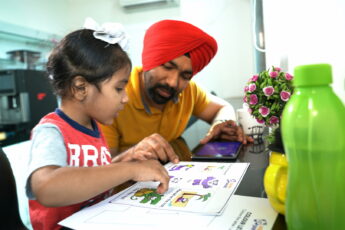Educational Games As A Teaching Aid
When I say the word ‘game’, what image comes to mind?
Is it a video game, complete with players in headsets blasting away at imaginary enemies?
Or do you go more old-school and imagine a rousing game of cricket or football?
What was previously strictly in the ‘fun’ category is now slowly entering the educational sector, with more and more schools globally adopting educational games into their curriculum. Serving as an aid and prop, these educational games explain concepts simple and complicated, reinforce learning, and give the teachers some much needed spare time while in the classroom.

We believe schools in India can benefit from this trend of using educational games as teaching aids too…here’s why:
Fact #1: If You Can’t Beat Them, Find A Way To Productively Join Them
There’s no way to escape ‘screen time’ or the time a person spends in front of the screen (which is 6 hours per day, on an average). Devices have infiltrated every aspect of our lives, and shows no signs of stopping. Introducing educational games will have dual benefits—your students are turning screen time into learning time, and this also serves to increase their digital literacy. Additionally, students will be better equipped for learning when their private lives are filled with similar media.
Fact #2: ‘Funning’ Up The Learning Process
Whether it is adding some new life to your classroom, or just trying to keep the students engaged, educational games can come to your rescue. Long experience has taught us that beginner learners acquire faster when taught through play. Adding an educational game to your existing aids mixes that fresh element of fun to the learning process.

Liked this image? Check out more on our Instagram and Facebook pages.
Fact #3: Fail ‘Safely’
These kinds of educational games rarely have any punishment for incorrect answers, at least not the traditional kind. The are mostly programmed to give out positive feedback even if learners are making mistakes. This feature ultimately boosts students’ confidence by having them ‘fail’ safely. Also, a “Whoops, try again!”, sounds so nice when it is coming from a cuddly little animated character, doesn’t it?

Fact #4: The Reward System Gets An Upgrade
Straying away from the traditional means of rewarding students, educational games give out bonus points, unlock new levels, and more, for well-performing students. This added motivation can enhance stimulation and engagement like little else can.
Fact #5: There Is Safety In This Game
It’s an educational game whose target audience is not allowed to cross the street by themselves; they cannot afford even a whisper that their game is an unsafe environment for kids. Most such games undertake very stringent measures to guarantee a safe and controlled playing space for users. Of course, we recommend taking the game(s) for a test drive before introducing them in your classrooms.
Psst, Square Panda offers a completely safe and ad-free environment for kids as they learn the English language.
Fact #6: Supercharged Learning
Educational games for kids are often an all-in-one kind of buffet, reinforcing many of the essential skills taught in the classroom, like social and emotional skills, fine and gross motor development, and more. Information taken in here is not static and one-dimensional, but constantly changing and interactive.

Fact #7: Instant Feedback
Learners get feedback on correct or incorrect words instantly. Teachers, too, get their students’ progress relayed to them as their charges are playing.
Fact #8: Learning To Learn
Children need to know learning is more than just rote memorization of facts and concepts. With educational games, they have an increased chance to fall in love with learning. These games show children a different way to learn, challenging their brain constantly, using different ways to train them in the subject, increasing their all-round development and problem-solving skills.
Fact #9: What Gap?
Research shows children from upper income households often produce better results than children from lower income households. Schools can do their part to reduce the gap by incorporating an educational game into the curriculum. Each child gets equal playing time, constant repetition and subsequent reinforcement of essential concepts.
Like anything else, there are challenges to using educational games in the classroom—teachers have to know the game before they can teach students to learn with it, there might not be sufficient resources to get this technology into the school, and integrating the game with the existing lessons. Square Panda anticipated this problem and provides teacher resources, along with a lesson plan suggestions, to ensure smooth implementation of its educational games in teaching. You can also browse through our game page, which gives you a glimpse into our amazing array of learning games for toddlers and kids aged 2-8.
So are you ‘game’ to try this new teaching assistant? Share your views with us! Which kind of learning game would you prefer in your classroom?
– Sanjana Shukla, Content Writer, Square Panda India




Leave a Comment